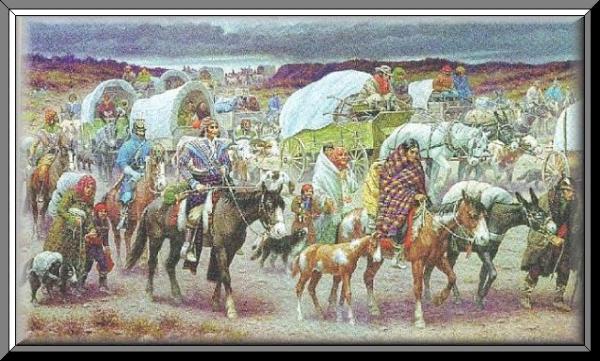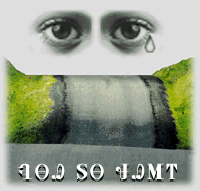
Trail of tears
 |
| Once there were ten million Native Americans on this continent, but ninety percent of it was either wiped out by disease, famine, or warfare. This only took about three-hundred years and people moving to this continent. By the year of 1840 all Eastern tribes had been moved west of the Mississippi River. There was pressure from citizens on the government to remove all Indians far west. One main reason for this was that the Indian tribes were uncivilized and therefore unworthy of maintaining their hold on land desired by white Christian farmers. Five tribes of the Southeast that were known as the "Five Civilized Tribes" were: the Choctaw, the Chickasaw, the Seminole, the Creek, and the Cherokees. The Cherokee Indians were known as the "Treaty Party" because they began negotiating a treaty with the government. The government made a treaty called The New Echota Treaty signed in 1835. The Cherokee Indians signed the treaty which said that the Indians give the government all the land East of the Mississippi River and they would get five million dollars in return. Also the Cherokee agreed to move west of the Mississippi River to Indian Territory, present day Oklahoma. |  |
| This was just the beginning. In 1838 President Martin Van Buren ordered the implementation of the Treaty of New Echota. Now the U.S. Army under command of General Winfield Scott began rounding up the Cherokees and moving them into stockades in North Carolina, Georgia, Alabama, and Tennessee. All in all a total of thirty one forts were constructed for this purpose. There were thirteen in Georgia, five in North Carolina, ten in Tennessee, and one in Alabama. In a report for July 1838 seven camps in and around Charleston Tennessee, contained more than four-thousand eight hundred Cherokees. At one fort, Gunstocker Spring, there were almost two-thousand Cherokees being held. The reason they were placed in camps was so that none of the Indians would escape. From these camps they were to be moved to Indian Territory. This was to occur in the fall of 1838, but did not due to bad weather. The army was now to move thirteen thousand Cherokees in the spring of 1839. |
| The Indians were being moved eight-hundred miles. The Cherokees were fed very little and they suffered malnutrition. They were badly clothed for the spring. Many of the Indians tried to escape, only some succeeded. Those who did escape hid in the mountains. The Indians knew the land very well so they had no problems getting around and finding food. |
| The journey to Oklahoma took between one-hundred four and one-hundred eighty nine days. Before their arrival they endured torrential rains, ice storms, disease, and broken heartedness. This claimed the lives of at least four thousand men, women, and children. One Georgia soldier who took part in the removal wrote, "I fought through the War Between the States and have seen many men shot, but the Cherokee Removal was the cruelest work I ever knew." Indians were transported by both land and river. General Winfield Scott had over 600 wagons, steamers, and keel boats. They moved almost sixteen thousand Cherokee by land and water. Those who traveled by water left on June 6 by steam boat and barge. They made it fine with not many problems. The next two groups didn't do so well. They suffered from drought and disease. The disease was mainly among the children. The other two groups did not arrive until the end of the summer. |
| Those who did not travel by river traveled by foot. The Indians traveled in detachments. Detachments were big groups of Indians that had been split up to get to Indian Territory. These detachments consisted of about seven-hundred to one-thousand six hundred Indians each. Those who had signed the Treaty of New Echota were put in a different detachment lad by John Bell. Also this group was administrated by U.S. Army Lt. Edward Deas. Most detachments had a physician. Some conditions made the journey very rough. Road conditions, illness, and distress of winter made death a daily occurrence. After the Indians had moved and gotten settled in they started schools. They decided that no matter what their children needed education. |
| Some white people spoke out for the Cherokees but there were not many. Henry Clay, Daniel Webster, and Davy Crockett area few who spoke on behalf of the Cherokees. The government and the citizens just ignored them though. President Andrew Jackson was one of those who signed and finalized the treaties for the removal of the Indians. Andrew Jackson, though, had been severely wounded at the Battle of Horseshoe Bend. He was saved by Chief Junaluska, a Cherokee. Over time leading up to this awful event the Indians signed over forty treaties. The total mortality rate during the removal and the aftermath was approximately eight-thousand. This event was all mainly because of gold, migration, and want of land. The Indians were here first, but were killed and kicked off their land just as quick as the Europeans moved in. |
|
Bibliography |
| "Trail Where They Cried"< http://powersource.com/cocinc/history/trail.htm> (May 5, 2005) |
| "Trail of Tears" <http://nativeamericans.com/TrailofTears2.htm> (May 9, 2005) |
| "The Trail of Tears" <http://www.studyworld.com/trail%20tears.htm> (May 10, 2005) |
| "The Trail Where They Cried" (background) <http://shadowwolf.org/> (May 12, 2005) |
| "Trail Where They Cried" (picture) <http://www.powersource.com/cocinc/history/trail.htm> (May 12, 2005) |
| "Trail of Tears" <http://www.pbs.org/wbgh/aia/part4/4h1567.html> (May 9, 2005) |
| "Trail of Tears" <http://www.globalsecurity.org/military/ops/trail-of-tears.htm> (May 10, 2005) |
| "An Infamous Journey to an Unfamiliar Land" <http://www.imagesbuilder.com/cherokee/tears.html> (May 10, 2005) |
| Amanda
Cahill
8th American History 2005 Project |